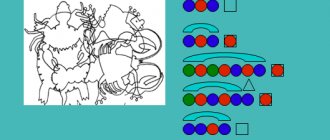How different are these consonant sounds?
There's a lot of trouble with letters, that's the kind of people they are.
Sounds change without asking and pretend to be different.
How much trouble these letters and sounds cause for children! Learn the letters, and then remember when and what sound they represent! And there are oh-oh-oh so many sounds. How can you remember all the voiced and voiceless consonants ?
Everything turns out to be very simple if you set up your child correctly.
I have already written about hard and soft consonant sounds. But consonants are not only hard and soft, but also voiced and unvoiced. And they cause so much trouble for children in the form of mistakes! How to teach a child to correctly identify voiced and voiceless consonants ?
Simply memorizing voiced and voiceless consonants is a losing proposition. Even if the child remembers, it will be very difficult for him to apply this knowledge. But if a child understands how voiced and unvoiced sounds are made, learns to hear them and identify them by their signs, then it will be easy for him to remember.
Let's first figure out the voiced and voiceless consonant sounds .
In the Russian language, consonant sounds are divided into voiced and voiceless, depending on the participation of the voice in the pronunciation of the sound. How to determine this? Say a single consonant sound and place your hand to your throat. If the vocal cords vibrate, it is a ringing sound. If not, then you are deaf. Check with your child and pronounce the sounds B - P, M or X. Did you notice?
Voicedness or deafness can be defined differently. Cover your ears with your palms and say a consonant sound. Did you hear a voice or noise? If a voice is heard, then the sound is ringing, if the noise is dull.
And this way you can easily and simply determine the voicedness or dullness of a consonant . At first, this method is very good. But if the child continues to determine the voicedness or deafness of a consonant in this way, then this will take a lot of time. The child will not have time to complete work in class. Therefore, it is necessary for the child to remember voiced and voiceless consonants.
And here we need to remember that the brain can perceive information in different ways - through hearing, vision or sensations. This means that in order for a child to remember information, it is necessary to influence all the child’s systems.
By determining the voicedness and deafness of consonants by ear, we have already included hearing in the work. By putting our hand to our throat, we connected the sensations. Now we need to connect our vision. To do this, you need to make a sign or drawing, where you denote the voiced and voiceless consonants with some symbols.
Voiced and voiceless consonants are paired and unpaired. This means that when creating such a diagram or tablet, you need to place paired consonants side by side. You can use any symbols that remind the child that the sound is voiced or unvoiced. So in this scheme, voiced consonants are indicated by a bell, and voiceless consonants are indicated by headphones.
Draw a similar sign with your child. Let him independently place the letters near the desired symbol, and you just control and guide the child’s actions. Remember that a person will only remember well what he did on his own.
Play with the placement of letters on floors or houses with the desired symbol several times and the child will perfectly remember the voiced and voiceless consonants. Hang this sign in a visible place and periodically return to it, ask the child to tell, show, name some sounds.
So, by playing, repeating already familiar properties of sounds and letters, you will help your child learn the basics of the Russian language without difficulty, remember voiced and voiceless consonants .
Have questions? Write in the comments to get an answer.
In the meantime, get some positivity and watch a wonderful cartoon. Let's learn from this cheerful monkey to find the good in everything.
How to teach a child to distinguish sounds
Children perceive information best if it is presented in a playful way. Together with your child, come up with an interesting story that will help explain the complex relationship between hard and soft consonant sounds.
Once upon a time, hard and soft sounds lived together. There was no enmity or quarrel between them, until one day an ambitious group of vowels, which included E, Yo, Ya, Yu and I, wanted to gain power over everyone. A war began that lasted for many years. A, O, U, E and S remained neutral and preferred to stay away, because they could not take anyone’s side. The war dragged on, so the vowels decided to use cunning. They turned for help to a soft sign, which does not have its own sound at all, but loves to pit others against each other.
This harmful letter told the vowels about the place where the consonants were hidden, and in return demanded a number of privileges after the successful completion of the military campaign. As a result, the consonants were surrounded. A group of militant vowels gave them an ultimatum and those who agreed had to accept their terms. The war was lost and the winners celebrated their success with pomp.
A small group of vowels received undivided power. Now they determine whether the consonant sound will be soft or hard. The soft sign received exactly the same rights. Now he, too, can push around the vanquished. Although among those who agreed there were also those who did not want to put up with the circumstances. All the hissers, along with a couple of comrades-in-arms, did not raise the white flag and went to partisans in the forests. The compliant consonants now strictly obey the laws of the vowels, and a few rebels continue to carry out sabotage activities, although without much results.
This simple story clearly demonstrates the peculiarities of the relationship between vowels and consonants. The names of the rebels that we will mention later should be immediately blacklisted. They are still wanted by the vowels for their disobedience. A "Wanted" sign can be placed on the refrigerator or near your little student's desk.
This hint should be constantly in front of the child’s eyes. The remaining consonants, which submitted to the victors, are now forced to become either soft or hard depending on their neighbors. If they are followed by the vowels E, E, I, Yu, I or b, then they become soft because they lose their will in front of the winners. If another vowel (A, O, U, E or Y) or consonant lands on their tail, then they become firm, as they feel support.





